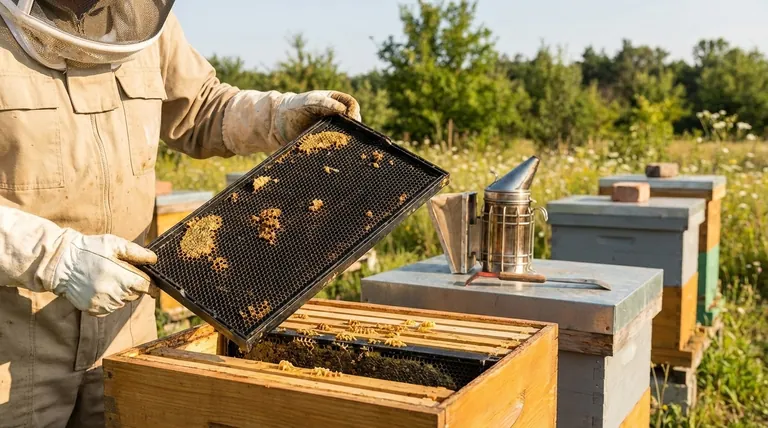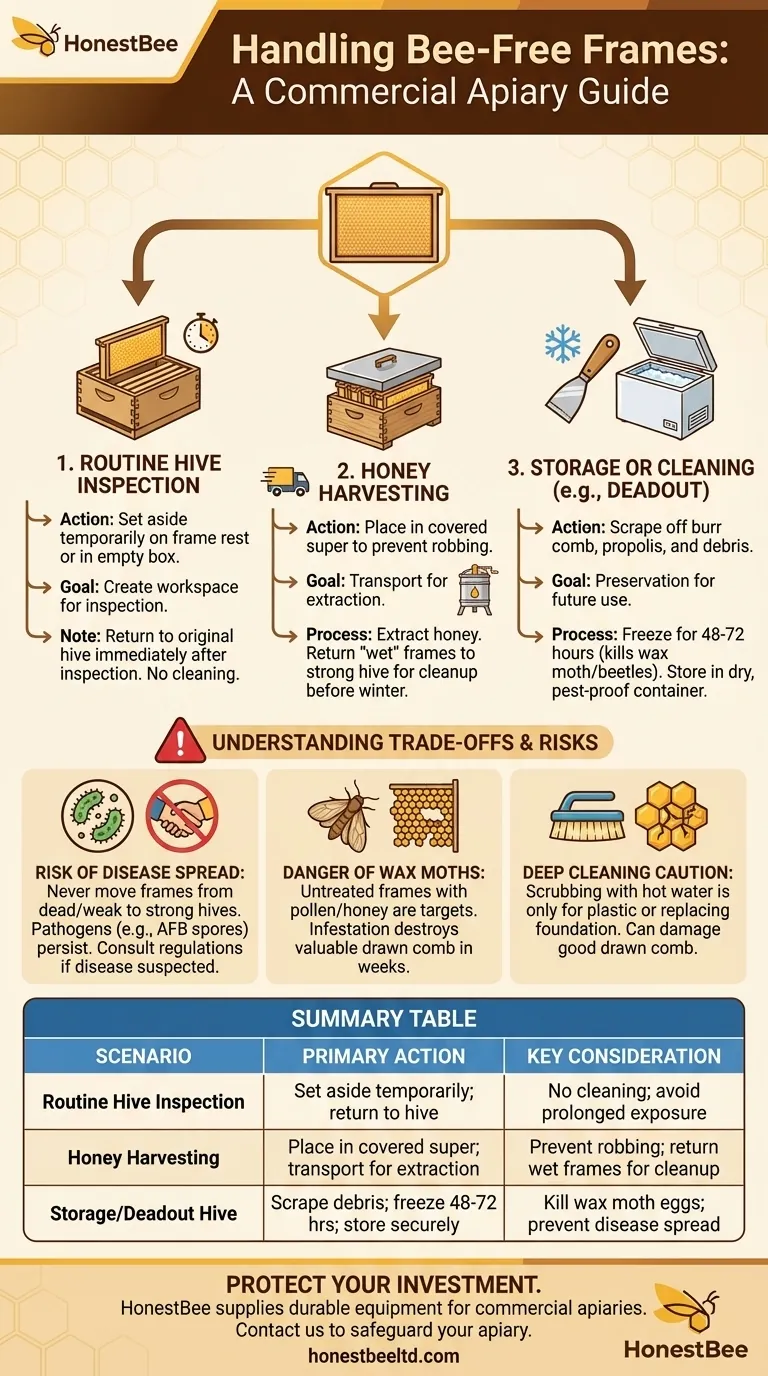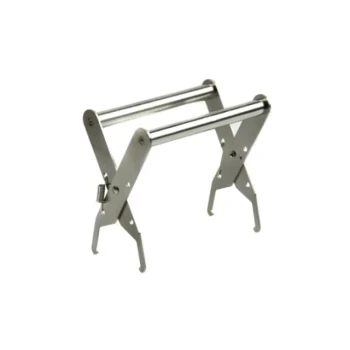Immediately after shaking bees from a frame, your next action depends entirely on your goal. If you are conducting a simple hive inspection, the frame is set aside temporarily and returned to the hive. However, if you are harvesting honey or removing frames from service, they are placed in a covered box for transport, storage, or cleaning.
The core principle is that a bee-free frame is not just an object to be put away; its handling is dictated by its purpose. Whether you are returning it to the hive, extracting honey, or storing it long-term determines the necessary steps to protect both the frame and the health of your bees.

The Context Defines the Action
What you do with a bee-free frame is determined by one of three common beekeeping scenarios. Each has a distinct process and objective.
For Routine Hive Inspections
During a standard inspection, you remove a frame primarily to create space to work. Once cleared of bees, this frame is typically placed on a frame rest that hangs on the side of the hive body or set carefully in an empty box.
Its purpose is temporary removal. The frame is returned to its original position in the hive at the end of the inspection. No cleaning or other processing is required.
For Honey Harvesting
When harvesting honey, frames are shaken or brushed free of bees and placed into an empty super. This super must be kept covered immediately to prevent robbing by bees from other colonies.
These frames are transported to your extraction area. After extraction, the "wet" frames (still sticky with residual honey) are often returned to the original hive for the bees to clean and repair before winter.
For Storage or Cleaning (e.g., from a "Deadout")
If you are removing frames from a dead hive or taking them out of rotation, your goal shifts to preservation and sanitation for future use.
The first step is to scrape off any excess burr comb, propolis, and debris from the wooden parts. The drawn comb itself is an incredibly valuable resource, representing a huge energy investment by the bees, so it should be preserved if possible.
After scraping, the frames must be prepared for storage. This usually involves freezing the frames for 48-72 hours to kill any wax moth eggs or small hive beetle larvae before they can cause damage.
Understanding the Trade-offs and Risks
Improperly handling used frames is one of the easiest ways to spread problems throughout your apiary. Understanding the risks is critical.
The Risk of Spreading Disease
Never move frames from a dead or weak hive into a strong hive without a clear understanding of why the first colony failed. Pathogens, particularly spores from diseases like American Foulbrood (AFB), can persist on equipment for decades.
If you suspect a serious disease like AFB, do not attempt to clean the frames. They should be burned or disposed of according to local apiary regulations to prevent a catastrophic outbreak.
The Danger of Wax Moths
Frames containing pollen or residual honey are a prime target for wax moths. If stored without being treated (typically by freezing), a wax moth infestation can completely destroy valuable drawn comb in a matter of weeks, reducing it to a mess of webbing and debris.
To Deep Clean or Not to Deep Clean
The reference to scrubbing frames in hot water is a deep-cleaning method, but it is not always necessary or desirable. This aggressive cleaning is typically reserved for plastic foundation or for frames where you intend to replace the wax foundation entirely.
Scrubbing can damage perfectly good drawn comb, forcing the bees to expend significant energy to rebuild it. For most storage situations, scraping the wood and then freezing the frame is a safer and more efficient method.
Making the Right Choice for Your Goal
Your handling of bee-free frames must be a conscious decision based on your objective.
- If your primary focus is a quick inspection: Simply set the frame in a frame holder or empty box and return it to the same hive when you are finished.
- If your primary focus is harvesting honey: Place frames in a covered box to prevent robbing, and after extraction, return the wet supers to a strong hive for cleanup.
- If your primary focus is storing frames for next season: Scrape the wooden components, freeze the frames for at least 48 hours to kill pests, and store them in a dry, ventilated, and pest-proof container.
Ultimately, treating your frames as a valuable and sensitive resource is key to successful and sustainable beekeeping.
Summary Table:
| Scenario | Primary Action | Key Consideration |
|---|---|---|
| Routine Hive Inspection | Set aside temporarily; return to hive | No cleaning needed; avoid prolonged exposure |
| Honey Harvesting | Place in covered super; transport for extraction | Prevent robbing; return wet frames for cleanup |
| Storage/Deadout Hive | Scrape debris; freeze for 48-72 hours; store securely | Kill wax moth eggs; prevent disease spread |
Protect Your Investment with the Right Equipment
Proper frame handling is essential for hive health and productivity. At HONESTBEE, we supply commercial apiaries and beekeeping equipment distributors with durable, wholesale-focused supplies designed to support these critical beekeeping practices. From storage containers to extraction tools, our products help you manage your frames efficiently and sustainably.
Let us help you safeguard your apiary. Contact our team today to discuss your equipment needs and ensure your frames—and your bees—are well cared for.
Visual Guide

Related Products
- Plastic Bee Frame Beekeeping Hive Frames for Wholesale
- Assembled Wooden Bee Frames with Beeswax Foundation Ready to Use by HONESTBEE
- Assembled Wooden Bee Frames with Plastic Foundation for Durability and Convenience by HONESTBEE
- HONESTBEE Wired and Assembled Wooden Bee Frames Foundation for a Thriving Hive
- Professional 500g Sectional Comb Honey Frame System for Beekeeping
People Also Ask
- What are the main types of frames available for beehives? Wood vs. Plastic for Your Apiary
- Are plastic frames good? Boost Apiary Efficiency with Durable, Pest-Resistant Frames
- What is a general rule for beekeepers with many hives regarding frame choice? Maximize Efficiency with Plastic Frames
- Are plastic bee hive frames good? A Guide to Modern Durability vs. Natural Appeal
- Why are plastic frames popular in commercial beekeeping? Boost Efficiency & Durability at Scale



















